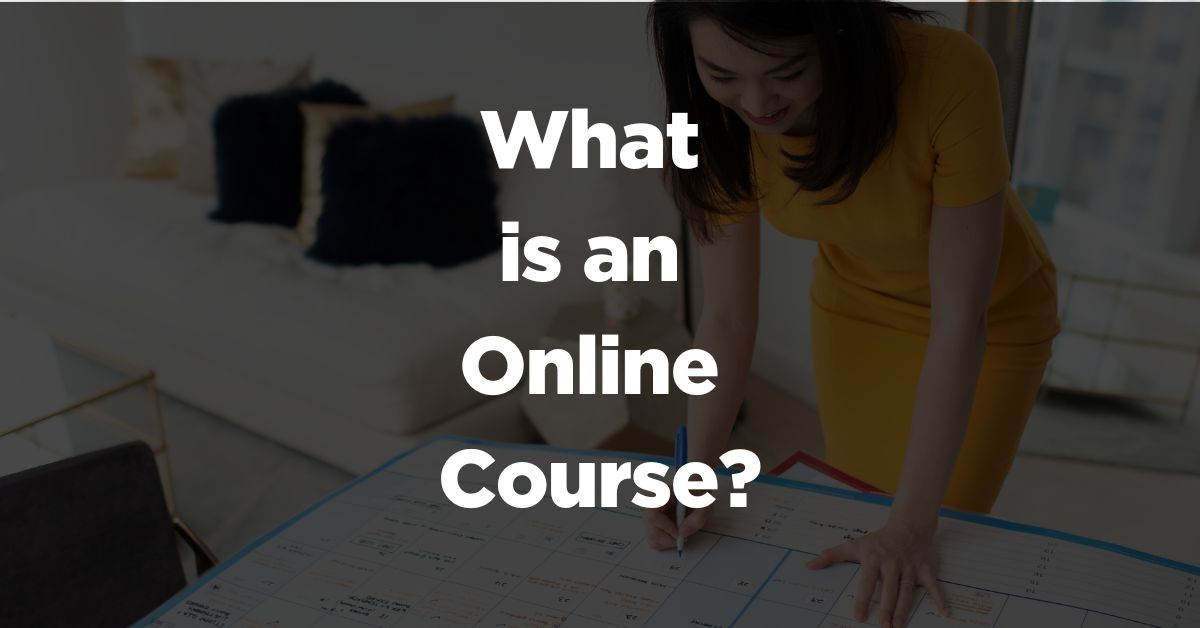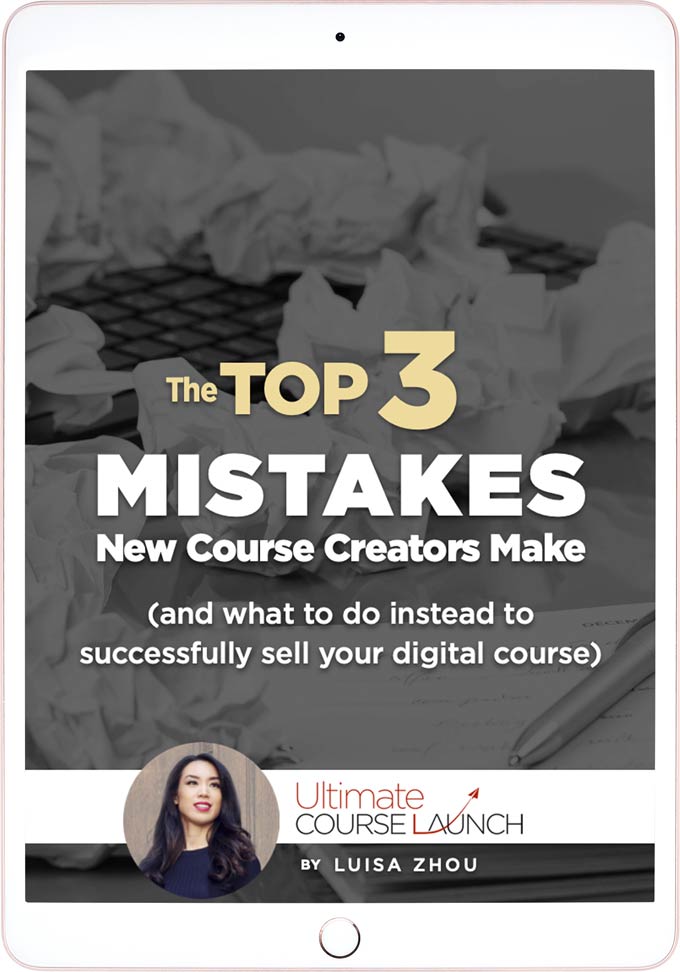This is the ultimate guide to online courses.
After all, courses are some of the most profitable products you can sell online. And if you have the right knowledge to package as a course, you could make a huge impact in people’s lives.
Want to learn more? Read on!
What is an online course?
An online course is an online learning program delivered fully online.
Online courses can vary in length – from a few hours to several months. However, there are courses on everything.
For example, there are courses on engineering, computer programming, baking, and dog training, just to name a few.
And the online education market is booming. In fact, the industry is expected to reach $200 billion in 2024.
Elearning courses come in a lot of different formats, too.
They can be asynchronous and completely self-paced with no live interaction from the course creator. You only need an internet connection to get started.
Or they can be synchronous and involve live group calls. The course materials can be delivered through pre-recorded video lessons, live webinars, discussion forums, assignments, PDFs, and more.
Plus, there is a ton of variety in the online course market. We’ll talk more about the different types later.
But is it worth it for you to create and sell online courses? Let’s talk about it.
What are the benefits of online courses?
So what are the benefits of online courses?
They are:
- Accessibility: Students can access an online course anywhere, anytime, and at a fraction of the price it would take them to learn the course content on their own or from traditional courses. That makes incredibly valuable information way more accessible than ever before.
- Flexible: Online courses can be self-paced, cohort-based, delivered live, and so on. There are also email courses, video courses, PDF-based courses, or a combination of formats. You get to choose how you want to conduct an online course.
- Scalable: Especially with self-paced courses, you create the product once and can continue to sell it. That makes online courses great passive income streams.
- Impactful: You can widen your impact as an expert in your niche with an online course because you can sell it worldwide to hundreds or even thousands of students. So you can help people from around the world achieve their goals with one product.
- Profitable: Because online courses are so scalable, they can be highly profitable. The expenses to run an online course business are also much lower than other business models.
Next up: Examples of top-selling online courses.
Top online course examples
Now you’re probably wondering, what are the best types of online courses to sell?
Well, there are successful online courses in every niche. But here are three examples of top-selling courses from myself and my students:
Employee-To-Entrepreneur by Luisa Zhou (me)
Employee-To-Entrepreneur is my flagship course. It’s a self-paced blueprint to help corporate employees break free of their day jobs and create their own Freedom Business. A Freedom Business is a business that allows you as a business founder to have more flexibility, profit, and freedom in your life. To this date, I’ve helped 1,000+ people start their own businesses.
Why does it work? I designed it based on my own experience and used my unique logical teaching style to help people achieve results. The course helps students avoid the mistakes I made and achieve financial freedom in their businesses. By using this method, I left my day job within just six months, and I’ve helped others do the same.
Lighting Bundle by the Academy of Animated Art
My student Jasmine was a successful 3D lighting artist, working for major studios when she realized something. It was tough for young artists to break into the industry, and degrees in animation were expensive. She built The Academy of Animated Art to offer top-quality animation courses for more accessible prices.
Why does it work? The Lighting Bundle includes seven mini self-paced video courses on how to do lighting animation and how to get a job as a lighting artist. It includes all the technical information to help students go from zero to hired.
Happily Hired by Cultivitae
My student Emily Liou was a professional recruiter for top Fortune 500 companies. And she’d seen all of the common mistakes that professional women make when going for their dream careers. So she started a career coaching company called Cultivitae to help mid-level career women achieve their career goals. The main product? A self-paced course with over 20 hours of video training called Happily Hired.
Why does it work? Happily Hired uses Emily’s professional experience to guide career women through the process of finding their dream job. She uses each module to help her students achieve a milestone in their career journey. She also offers the course with one-on-one coaching support as an upsell.
Different types of online courses
Now. let’s talk about the many online courses you could create:
- Self-paced course: A self-paced course has little to no interaction with the course creator. Instead, students go at their own pace through the pre-recorded or pre-written material to achieve their goals.
- Live course: A live course is when you deliver the course live. That could be in live lectures or webinars. Or it could be sending emails to your students with the next steps.
- Certificate course: A certificate course is a course that ends with a certification. It could be a certification accredited by a professional organization or by your company.
- Hybrid course: A hybrid course is a blend between a live course and a self-paced course. Maybe some modules are taught live but others are not. Or maybe the course is mostly self-paced but includes some live group calls where students can ask questions. You get to decide how your course is delivered.
- Massive open online course (MOOC): A massive open online course (MOOC) is a free, online course that anyone can take at any time. It’s asynchronous because everyone starts at different times and you don’t have any interaction from the course creator. Typically, these are hosted by universities to make education more accessible.
What makes a great online course?
So you want to sell an online course? Here are the key things that make it worth buying:
- Easy to learn: I always say that you’re selling the transformation, not information. With a course, you’re selling high-quality information that leads to transformation. It’s not about adding an overload of information – just the stuff that matters to help your students achieve their goals.
- Clear milestones and modules: In a course, you’re organizing the information in a way that will lead to transformation for the student. And this is completely unique to you. What someone is buying is your specific way of organizing the content because they think the way you do. For example, I’m a very logical person as a former engineer. So my courses are no fluff, logical step-by-step products that lead to a tangible result.
- Personal or professional experience: Your students are paying to hear from someone who has experienced or helped others experience the transformation you’re promising. Learning from someone with first-hand experience completely changes the energy of the course.
- Support: Offer support material that helps your students achieve their goal – these could be eBooks, worksheets, templates, and bonuses. Plus, coaching is a great value-add, especially when you sell your first course.
- Proof: Testimonials, reviews, and case studies show future students that they can achieve great results with your course too. In one study, 63% of people were more likely to make a purchase if the site had reviews. So add social proof to show that your course really works.
Want to learn more about what sells courses? Here’s a helpful video:
How to create an online course
Ready to start creating your online course? Here are the basic steps:
Pick a profitable course idea
The best course idea answers these two questions:
- What skills do you have?
- What do people want?
Starting with your skills, write down all of the things you’ve learned from your day job and hobbies that you could make a course about.
One of those things will stand out as something you’re more able to teach.
Next, what do people want?
You can figure this out by researching your niche online and seeing what people are asking. You can also coach a few private clients (by taking on coaching or consulting clients) to understand their pain points.
Now you have a course idea, it’s time to outline the course.
Structure your course
Next, create a course outline.
First, decide on the learning outcomes – what goals will your students have learned at the end of the course?
Then, identify the main milestones that will lead to that goal. One milestone represents a module in your course.
Then break down the modules into smaller lessons to make it easier.
As a rough guide, your first course should be 4-8 modules with 3-5 lessons in each module.
Create your course content
Now you have the outline of your course mapped out, creating the content is easy.
You have a wide range of formats to choose from:
- Video tutorials
- Screen recordings/screenshots
- PDF workbooks
- Email sequences
- Audio files
Whatever works best for the content you’re teaching.
As a rule of thumb, video courses with PDF workbooks tend to be perceived as higher value and work for most niches.
Choose the right course platform
Once you have your course, you need a place to upload and sell it.
There are three options:
- Your own website
- An online course platform (like Teachable)
- A course marketplace
I personally prefer selling courses from my own website for a number of reasons – I have full ownership and control of my course, I maximize my profits, and so on. However, we’ll go through a few course platforms below, if that’s the option you want to go for.
Set a course price
To sell your course, you also need to decide on a course price.
This is fairly simple; for your first course (a shorter online course with videos and PDFs), price your course at $197-$497.
When you create a longer online course, a flagship course, you can price it at $1,000 to $3,000.
Launch your course
You don’t need a huge audience to sell out your online course.
With a smart launch strategy, you can build an audience while you launch.
How? Launch with a live challenge that encourages people to sign up for your email list.
Example: I sold my first course with a live challenge called the Weekend Empire. It was a five-day challenge with daily advice on how to start a profitable business.
At the end of the challenge, post the link to purchase your course if they want to learn more from you.
If you want to learn more about how I sold out my first course, check out this video:
The top online course websites
Want to host your course on another platform than your own website? Then, here are some of the top online course websites:
- Teachable: Teachable is an online course platform where you can create and host your course.
- Thinkific: Like Teachable, Thinkific is a course platform with drag-and-drop tools.
- Kajabi: Kajabi is another course platform for course creators who want to sell a course, but not on their own website.
- Udemy: Udemy is a course marketplace, which hosts courses and markets them to their audience against a commission.
- Coursera: Coursera specializes in degrees and certificate online courses by universities and larger companies.
- edX: This marketplace hosts mainly free university courses and online classes.
Next steps
There you have it! The answer to the question “What is an online course?” and how you can get started with creating your own.
But this is just the beginning. If you want to be a successful online course creator, there are some big mistakes you need to avoid.
Download my free guide on the top three mistakes course creators make so you can make a profitable online course business for yourself.
Read more:
The Most Profitable Online Course Ideas (+ Examples)
Online Course Design: How to Design a Remarkable Course
The Best Course Creation Software








